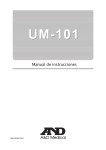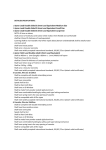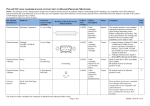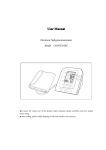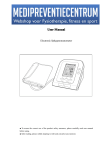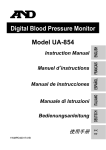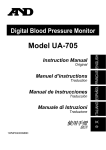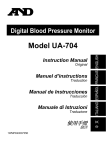Download A&D UM-101 Instruction manual
Transcript
Instruction Manual Manuel d’instructions Manual de instrucciones Manuale di Istruzioni Bedienungsanleitung 使用手册 WM+PD4001301 UM-101 Digital Sphygmomanometer Instruction Manual Contents 1. Dear Customers ................................................................................2 2. Preliminary Remarks .........................................................................3 3. Notes for Proper Use.........................................................................4 4. Parts Identification .............................................................................6 5. Symbols.............................................................................................7 6. Using the Monitor ..............................................................................8 7. Measurements...................................................................................9 8. Useful Features ...............................................................................10 9. Troubleshooting............................................................................... 11 10. Maintenance .................................................................................... 11 11. Technical Data .................................................................................12 English 1 1. Dear Customers Congratulations on purchasing a state-of-the-art A&D sphygmomanometer, one of the most advanced monitors available on the market today. Designed for ease of use and accuracy, this monitor will facilitate your daily blood pressure regimen. We recommend that you read through this manual carefully before using this device for the first time. Applicable Patient: Environment for use: This sphygmomanometer is designed for use on adults only. The device is for indoor use. Features Measurement This sphygmomanometer is designed to monitor and display the cuff pressure during cuff inflation and deflation while the healthcare provider determines the patient’s blood pressure level by listening for Korotkoff sounds with a stethoscope. Easy to Use This sphygmomanometer measures the pulse rate of a patient while the cuff is deflating during blood pressure measurement, and indicates the pulse rate on the LCD display. Safety This sphygmomanometer was designed to measure a patient’s blood pressure without the use of mercury, therefore protecting your local environment. An automatic quick exhaust valve is installed in the device to prevent over pressurization of 320mmHg or higher, therefore protecting the patient. English 2 2. Preliminary Remarks Compliance Compliance with European Directive 93/42 EEC for Medical Products The device conforms to the following requirements: European Directive 93/42 EEC for Medical Products; Medical Products Act; European Standards for Electrical Medical Equipment EN 6060-1 (General Safety Provisions), EN 60601-2-30 (Particular Requirements for the Safety of Automatic Cycling Indirect Blood Pressure Monitoring Equipment), EN 60601-1-2 and EN 55011 (Electromagnetic Compatibility); European Standards pertaining to Non Invasive Blood Pressure Instruments EN 1060-1(General Requirements), prEN 1060-3(Supplementary Requirements for Electrome-chanical Blood mark Pressure Measuring Systems). The above is evidenced by the of conformity accompanied by the reference number to the involved notified body. This device is designed for adults only. Definitions SYS DIA PUL Exhaust Constant exhaust Systolic Blood Pressure Diastolic Blood Pressure Pulse This means “releasing the cuff air as soon as possible”. This means, “releasing the cuff air at a constant depressurization rate”. Batteries Use alkaline batteries (LR6 type, AA type, Mignon) or equivalent batteries. Do not mix new and used batteries. Remove the batteries if the device will not be in use for a prolonged period of time as the batteries may leak and cause a device malfunction. A Defective Sphygmomanometer Stop the examination immediately if the device does not work properly. Please attach a note with the following "Do not use this sphygmomanometer " to prevent any further use. This defective device should be stored in a safe place to avoid any misuse until it has been sent for repair. English 3 Training The healthcare provider should stop the examination if there is an abnormality, such as a patient feeling excessive arm pain, and remove the cuff to protect the patient. Repair Do not attempt to open the device. Contact your nearest A&D authorized representative and they will repair or replace the device. Blood Pressure Measurement This device is designed for use with adults. Do not use the device on patients using heart-lung support equipment. Do not use the device on patients in a critical condition or on ICU (intensive care unit) patients. 3. Notes for Proper Use Storage Do not store the sphygmomanometer in the following places. Where the device could be splashed with water or other liquids. If the device is immersed by accident, it may require servicing. (DO NOT use the device before it has endured a full service.) Do not leave the device in a high temperature or high humidity environment, or in direct sunlight. Do not leave the device where it could be influenced by vibration or shock. Do not leave the device in a dusty, salty or sulfuric environment. Do not leave the device where medicines are stored, or where medicines are evaporating. Before Use Make sure that the sphygmomanometer works correctly and that measurement values are accurate. Make sure that the cuff and air tubes are properly connected. Check and maintain the cleanliness of the parts in direct contact with the patient. Consider using a cuff cover for sanitary measurements. Avoid placing the device near a strong magnetic field or static electricity. Avoid placing the device near high frequency surgical equipment. English 4 During Use This device should be used by trained professionals. Stop the examination immediately, if the patient feels pain during a measurement or if the device does not work properly. Stop using the device if you notice any abnormalities (for example; liquid inside the device) and request a full service. After Use Clean the device, cuff and accessories before any subsequent uses. Do not pull or kink the tubes. Do not use any organic solvent (for example; antiseptic solution, etc.) to clean the device. Press the ON/OFF button after a measurement. You are advised to keep the original box for further transportation after purchasing the device. Periodic Maintenance This device is a precision instrument and contains electronic circuitry. Please check all functions periodically. Contact your nearest A&D authorized representative for official calibration/check-up, according to your local regulations. English 5 4. Parts Identification Main Body and Accessories Cuff connector Pressure bar display Numerical display MARKER button ON/OFF button Exhaust valve Rubber bulb Cuff 1.5V Batteries (LR6 or AA) Band for attaching a stethoscope on the arm Instruction manual Function ON/OFF Button MARKER button Numerical display Turns on or off the device. During measurement............ Puts a marker at a pressure value After turned off ...................... Indicates a lifetime counter During measurement............ Indicates pressure value After exhausted air ............... Indicates pulse rate Display Unit of pressure Pressure value Battery indicator Pulse rate Unit of pulse High digits of the lifetime counter Low digits of the lifetime counter English 6 5. Symbols Symbols Function / Meaning Recommended Action Standby and Turn the device on. MARKER Pressure value holding and lifetime counter. Battery installation guide SN Serial number Date of manufacture Type BF: Device, cuff and tubing are designed to provide special protection against electrical shocks. Full Battery Low Battery The battery power indicator during measurement. The battery is low when it blinks. Pressure remains in Cuff. Exhaust it with the exhaust valve. Measurement overtime. Device is out of order. mmHg bpm Send for service. Unit of pressure Unit of pulse EC directive medical device label WEEE label English Replace all batteries with new ones, when the indicator blinks. 7 6. Using the Monitor Installing / Changing the Batteries 1. Remove the battery cover. 2. Insert a new set of batteries into the battery compartment as shown. Make sure the polarities (+) and (-) are correct. Use only LR6, AA or equivalent batteries. 3. Close the battery cover. CAUTION Insert the batteries in the battery compartment. If not, the device will not work. When (LOW BATTERY mark) blinks in the LCD display, replace all batteries with new ones. Do not mix old and new batteries. It may shorten the battery life, or cause the device to malfunction. Battery life varies with the ambient temperature and may be shorter at low temperatures. Use the specified batteries only. The batteries provided with the device are for testing monitor performance and may have a limited life. Remove the batteries if the device will not be in use for a prolonged period of time as the batteries may leak and cause a device malfunction. Connecting the Air Tube Insert the air tube into the cuff connector firmly. Selecting the Proper Cuff Using the correct cuff size is important for accurate readings. If the cuff is not the proper size, the reading may yield an incorrect blood pressure value. The INDEX and RANGE marking on the cuff will indicate that you are using the proper cuff or not. (Refer to "Attaching the Arm Cuff" in next section) Arm Size Recommended Cuff Size 33 cm to 45 cm Large cuff 23 cm to 33 cm Medium cuff 17 cm to 25 cm Small cuff Arm size: The circumference at the biceps English 8 Order No. AX-UM-101-03 AX-UM-101-01 AX-UM-101-02 Attaching the Arm Cuff 1. Wrap the cuff around the upper arm, about 2 ~ 3 cm above the elbow as shown on right. Place the cuff directly against the skin, as clothing may cause a faint pulse and could result in a measurement error. 2. Constriction of the upper arm, caused by rolling up a shirtsleeve, may interfere with accurate readings. 3. Make sure that the index points are within the range. 4. Attach a stethoscope on the arm with accessory band. RANGE INDEX Cuff 2 ~ 3 cm Band Stethoscope 7. Measurements 1. Place the cuff on the arm (preferably the left arm). Keep the patient still during measurement. At heart level 2. Press the ON/OFF button. When the ON/OFF button is pressed, all of the display symbols will appear for about one second. When starts flashing, the device is ready for measurement. If air is remaining in the cuff when the ON/OFF button is pressed, the display will indicate an error code Switch off the device (press the ON/OFF button again) and turn the exhaust valve counterclockwise once to expel all the air in the cuff. Then press the ON/OFF button again to reactivate the device. . 3. Place the stethoscope on the humerus artery and pressurize the cuff by squeezing the rubber bulb. (Make sure the exhaust valve is completely closed.) While the cuff is inflating, the pressure bar will move and in turn the LCD will display a number indicating the pressure. Inflate the cuff to 30 to 40 mmHg higher than the patient’s expected systolic value. Note: If you wish to stop inflation at any time, press either the or turn the screw of the exhaust valve to release the air. English 9 ON/OFF button 4. When inflation is complete. Turn the exhaust valve screw to release air slowly. Measure the systolic pressure and the diastolic pressure by stethoscopy. 5. The pulse rate is shown on the numerical display when the measurement is complete, and meets the following conditions. When you pressurize 80mmHg or higher for the measurement. When the pressure drops to 20mmHg or lower. 6. Turn the exhaust valve screw counterclockwise to release all the air from the cuff. If a measurement is taken with insufficient pressure, mark will be displayed. Re-pressurize the the cuff to a pressure that is about 30 to 40 mmHg higher than the previous attempt. An error message will be displayed if a measurement is taken with insufficient pulses or in a very noisy environment. 7. Press the ON/OFF button again to turn off the power. Note: Model UM-101 has an automatic power-off function. 8. Useful Features Measurement with MARKER Button You can put a marker at a certain pressure value when the MARKER button is pressed during the measurement process. Up to 5 markings can be shown over the range of 40mmHg. Marker Marker Lifetime Counter When the MARKER button is pressed while the device is off, the lifetime counter is displayed. This counter function indicates the hours the device was High digit in use and helps to determine when maintenance is necessary. High digits and Low digits are alternatively Alternatively displayed. The example indicates that the device has Low digit been in use for 1,278 hours. English 10 9. Troubleshooting Problem Nothing appears in the display, even when the power is turned on. Possible Reason Recommended Action Batteries are empty. Replace all batteries with new ones. Reinstall the batteries with their Battery polarities negative and positive ends matching are not in the those indicated in the battery correct position. compartment. The cuff is not Fasten the cuff correctly. fastened properly. Patient moved thier Make sure the patient remains very arm or body during still during the measurement. the measurement. The unit does Have the patient sit comfortably still. not take a The cuff position is Ensure that the cuff is at the same measurement. not correct. level as the heart. Readings are If the patient has a very weak or too high or too irregular heart beat, the device may low. have difficulty in determining thier blood pressure. Remove the batteries. Reinstall them properly and try the measurement again. Note: If the recommendations above do not solve the problem, contact your nearest authorized A&D representative. Do not attempt to open or repair this product by yourself, as any attempt to do so will render your warranty invalid. 10. Maintenance Do not attempt to open the device as the delicate electrical components and intricate air unit inside could be damaged. If you cannot solve the problem using our troubleshooting guide, request assistance from your authorized dealer or from any A&D service group. The device was designed and manufactured for a long service life. However it is generally recommended to have the monitor inspected every 2 years, to ensure proper functioning and accuracy. Please contact either your authorized dealer or A&D for maintenance. English 11 11. Technical Data Model Measurement method Measurement range Numerical display Pressure bar display Measurement accuracy Numerical display Pressure bar display Power supply Upper arm circumference Classification EMC Operating condition Storage condition Dimensions Weight UM-101 Stethoscopy with stethoscope Pressure: Pulse: Pressure: 0 ~ 300 mmHg 30 ~ 200 beats / minute 20 ~ 280 mmHg Pressure: ±3 mmHg Pulse: ±5 % Pressure: ±4 mmHg 2 x 1.5 V alkaline batteries (LR6 or AA) 23 ~ 33 cm using the medium cuff Type BF IEC 60601-1-2: 2001 +10°C to +40°C / 30%RH to 85 %RH -20°C to +60°C / 10%RH to 95 %RH Approx. 96 [W] x 322 [H] x 66[D] mm Approx. 940 g, excluding batteries Note: Specifications are subject to change without prior notice. English 12 A&D Co.,Ltd. 1-243 Asahi, Kitamoto-shi, Saitama 364-8585 JAPAN Telephone: [81] (48) 593-1111 Fax: [81] (48) 593-1119 A&D INSTRUMENTS LTD. <Authorized Representative Established in the European Community> Unit 24/26 Blacklands Way, Abingdon Business Park, Abingdon, Oxon OX14 1DY United Kingdom Telephone: [44] (1235) 550420 Fax: [44] (1235) 550485 A&D MERCURY PTY. LTD. 32 Dew Street, Thebarton, South Australia 5031 AUSTRALIA Telephone: [61] (8) 8301-8100 Fax: [61] (8) 8352-7409














